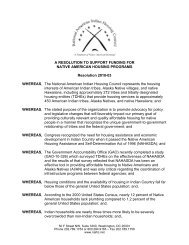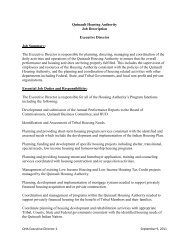CASE STUDY - National American Indian Housing Council
CASE STUDY - National American Indian Housing Council
CASE STUDY - National American Indian Housing Council
Create successful ePaper yourself
Turn your PDF publications into a flip-book with our unique Google optimized e-Paper software.
Executive SummaryPresident Clinton signed the Native <strong>American</strong> <strong>Housing</strong> Assistance and Self-Determination Act of 1996 (NAHASDA) into law on October 26, 1996. This newlegislation replaced several separate programs established under previous legislationknown as the United States <strong>Housing</strong> Act of 1937 with a single block grant.The purpose of NAHASDA is to provide federal assistance for tribes in a mannerthat recognizes the right of <strong>Indian</strong> self-determination and tribal self-governance.NAHASDA was implemented through the U.S. Department of <strong>Housing</strong> and UrbanDevelopment (HUD) regulations at Code of Federal Regulations 24 (CFR), part 1000. Anegotiated rulemaking committee comprised of 48 tribal representatives and 10 HUDrepresentatives developed these regulations.There are six eligible housing activities under NAHASDA. These fundable activities are:• <strong>Indian</strong> <strong>Housing</strong> Assistance• Development• <strong>Housing</strong> Services• <strong>Housing</strong> Management Services• Crime Prevention and Safety Activities• Model ActivitiesIn January 2001, the <strong>National</strong> <strong>American</strong> <strong>Indian</strong> <strong>Housing</strong> <strong>Council</strong> (NAIHC)developed a research design plan that was submitted to and approved by the U.S.Department of <strong>Housing</strong> and Urban Development Research Department. This researchdesign plan was formulated to use a case study approach to examine successful projectscarried out under the six general fundable housing activities of NAHASDA. Theobjective of the research is to provide tribes with information on different approaches andsuccesses in the utilization of NAHASDA for each of the fundable activities underNAHASDA.The research project was carried out in four phases, with the fourth phase beingthe final production and distribution of a publication. Special consideration was given toprojects that:• Had significant cultural relevance• Helped tribes overcome serious obstacles to program implementation• Provided an increase in housing development• Exhibited continuity of management• Provided an increase in community or tribal empowermentiii




